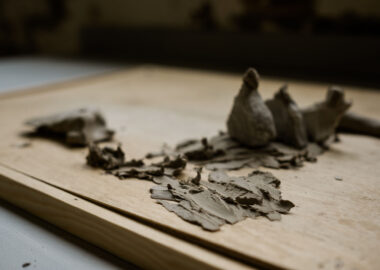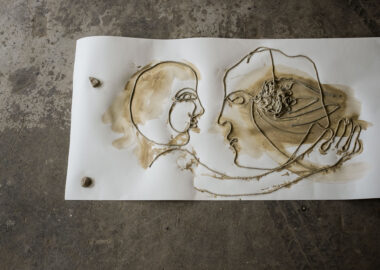Have you visited The Clay Quarter at Spode China Hall? Here’s some information around the concepts and development of this interactive and experimental space…
Week in, week out British Ceramics Biennial’s electric van, Clay on Wheels, is packed with clay and tools to go out to schools, museums, community and health settings across Stoke-on-Trent. With clay on the table, we have conversations, we question and explore. We learn things about clay, but also about ourselves and each other. At the end of the session, we clean up and return to our studio at Spode Works.
Preparing for the British Ceramics Biennial Festival 2019, we wanted to create an interactive space that represents this way of working and allows the wider community to experience our approach, and challenge perceptions of what working with clay can be: the Clay Quarter.
Background
The Clay Quarter concept is rooted in the work carried out for the Clay Pit, the interactive space designed by Dena Bagi, Priska Falin, and Helen Felcey for BCB2017 and hosted by BCB associate artists including Joanne Ayre, Alice Thatcher and Tamsin Williams. This award-winning space invited members of the public of all ages to experience clay in its different states within the industrial setting of a former ceramic factory. Artists encouraged participants to step out of their comfort zones and experiment with the material. The usual ‘rules’ of ceramics were not applicable here – wet clay could be mixed with fired clay to create constructions, slip (liquid clay) could be used to paint or print with, or dried clay could be used as building blocks.
A key focus of the Clay Pit was the temporal nature of the work created. Nothing was fired. Work was temporarily displayed for inspiration, but then recycled for use by future visitors. The emphasis of the activity thus turned from the product made to the time spent making it. Play and experimentation were actively encouraged, and the interaction with the material was prioritised.
Explore, experiment and play!
The Clay Quarter also emphasises time spent working, rather than the final product. The different spaces are designed to challenge your senses and invite you to question how you interact with clay, not what you will make.
How does it feel? What are the sounds you hear? What does the clay look like? And how does it change?
Many comment on the therapeutic nature of working with clay as a material, and there are certainly some aspects of mindfulness to working with clay in this way. However, what it also allows is time to play, permission to experiment and find out what works and what doesn’t, an environment where the pressure to make a certain thing or achieve a particular outcome is side-lined in favour of material exploration.
Our year-round programme
The year-round BCB engagement programme has also informed the development of the Clay Quarter. Working across three key strands – education, health, and communities – throughout the year we work with people and clay to instigate conversations about place, identity and cultural heritage. A central theme is how th e material of clay and the process of working with it can bring about social and cultural change within the city.
In the summer of 2018, we worked with Reach for the Stars Nursery to trial some sessions within an Early Years Setting. Working with artists Helen Felcey, Alice Thatcher, and Gabriella Rhodes we incorporated the concepts of Early Years Schema into the activity that we devised. Schema is a learning framework that seeks to identify children’s early learning styles and scaffold them through similar activity. Examples include ‘rotating’ schema, where a child might like to draw lots of repeated round shapes, or spend time twirling about in the playground, or ‘transporting’ schema, where a child may like to fill receptacles with objects and move them to different places.
How could we recreate these frameworks with clay? Some aspects lent themselves naturally, such as using small pieces of clay that can be filled into containers for transportation, while others took some more thought. The simplicity of this way of thinking about learning, and how we interact with the world, proved to be of great interest to our artists.
A person-centred approach
A person-centred approach is an integral aspect of the BCB engagement programme in education, health and community settings. Looking at how people react to the clay, how they interact with it, what they enjoy and respond to, informs the type of work that we do, enabling a more meaningful interaction with the material and learning experience.
On a recent project, artist Joanna Hejmej worked with patients in the Stroke Recovery Ward at the Haywood Hospital. As the work with this group progressed she noticed how the differing mobility needs of the participants impacted the way in which they worked. In response, Hejmej decided to trial different tools within the following sessions with the aim of making working with clay more accessible to those in the group. She found that with these new tools, participants started to incorporate the use of both hands within their working, where before they had found it difficult, and worked more intensely with the material as a result.
This reciprocal approach is at the heart of British Ceramics Biennial’s engagement work in Stoke-on-Trent.
The material is always the same, but as a result of this interchange, something always changes. We hope The Clay Quarter represents this dialogue. Rather than a static exhibit, one object or one image that doesn’t change, three artists, working alongside groups interested in clay, have designed, tested and created an interactive space that will continue to respond to visitors throughout this year’s festival.
The Clay Quarter will be a free engagement space within the 6th British Ceramics Biennial. It is situated in Spode China Hall on Spode Works site and will be open everyday between 7th September and 13th October.
We hope to see you there soon!


